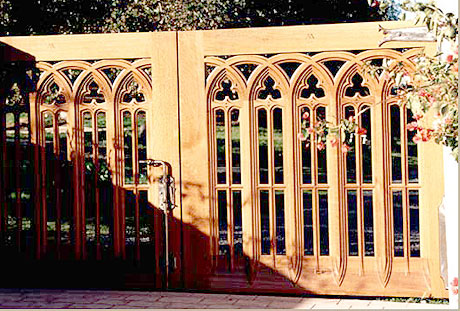
At 36, Aaron Radelow is single, footloose, fancy-free, and enormously talented. His diverse portfolio of flawlessly executed pieces includes everything from classic Queen Anne furniture and byzantine hand-carved gates to glitzy Art Deco tables and rustic Morris chairs, but it is his range of skills that really puts his talent into perspective. In the course of becoming a veritable Renaissance man of furniture making, he’s mastered blacksmithing, for special hardware; carving, marquetry and a range of finishing skills from faux techniques to classic French polishing, all on top of traditional cabinetmaking.
To be fair, he got an early start. He adopted his chosen craft not because it was a family tradition (it isn’t), but rather by default. “I started woodworking pretty much because I was horrible at everything else,” Aaron insists. “I hated math and English, but I flourished in shop all through junior high and high school. I had a really good woodshop teacher in junior high, and that got me interested initially. In contrast, the metal shop teacher was awful, and I suspect that if he had been the better teacher, I might now be making custom choppers instead of furniture.”
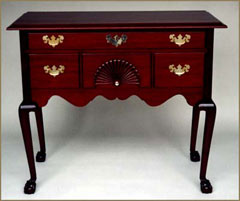
“I started working in the field right out of high school. My father, a German immigrant, insisted that I learn a trade first, so I went to work in a big cabinet shop in San Diego. There, I learned more about what not to do than what to do. After about two and a half years, I left, and spent the next decade in and out of a variety of woodworking shops.”
“I get bored doing the same thing day in and day out. I could never restrict myself to building just Shaker or craftsman furniture. Working in other people’s cabinet shops was the same thing, even in smaller studio shops. Besides, it involved someone else telling me what to build and how to build it. I didn’t like that either. I always wanted to experiment and push the envelope. You can make a lot of money building television cabinets, but that is not satisfying for me. I realized that I wanted to get ahead, but in a different way; by building ever more jaw-dropping pieces.”
To expand his abilities and allow him to try new things, he took classes in blacksmithing, and studied wood carving with the legendary Ian Agrell, a man he considers to be the best woodcarver in the U.S. Still, his path was not always a smooth one.
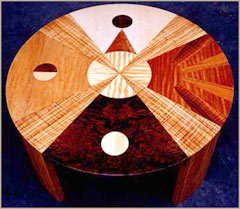
“After my studies, woodworking became somewhat of a struggle, and I got burned out. I was doing a lot of faux finishing, and a lot of distressed pieces, but I was the one getting distressed.” He found himself building furniture out of cheap wood and adding fancy finishes to hide that fact, all at the behest of designers who got a fortune for his work while squeezing him for the lowest prices. Fortunately, a turning point was in the offing.
“One day I was flipping through a magazine and saw an ad for the American School of French Marquetry. I went there and studied with the renowned Pat Edwards, learning about veneers, proper glues, marquetry and, perhaps most important, the construction of a chevalet.”
A Chevalet de Marqueterie, or “marquetry sawhorse,” is the cutting tool used by inlay artists to cut the elements of marquetry designs. Originally developed in the 18th century, it is the most useful tool for adroitly cutting the smallest of items. In the hands of a well-versed marqueteur, for example, the chevalet can precisely cut out design elements as small as a comma. Aaron, who made his own chevalet, also uses it to cut out carvings, and says it changed the way his entire shop works. “Visitors and clients always make a beeline for that tool when they first come in. It astonishes them that I would make not only the furniture, but the tools used to make that furniture.”
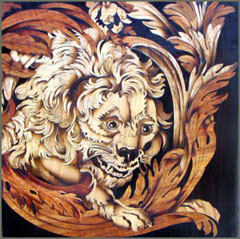
“Studying with Pat Edwards was a huge turning point for me,” Aaron told me. “After that, I started building really nice pieces. Before, I would walk into a museum and wonder how those things were made. Now, I look at them and know I can make them. It was all very empowering.”
“For example, I’m currently making a copy of a $10 million museum piece graced with blue cow horn and white ivory marquetry, and fitted with ormolu mounts.” Not surprisingly, he also made the ormolu mounts, crafting the traditional gilded bronze fittings with a variety of tools. “The piece, which is about the size of an ottoman, is like a little jewel.”
These days, he is out of his slump, and has more work than he can handle, including a marquetry chart table for a yacht, a carved walnut fireplace mantel, a teak bench and some antique chairs he is refurbishing. He credits that in part to an Art Deco drinks cabinet he made which won Best in Show at the 2004 San Diego Design in Wood Exhibition. That piece, along with a stunning lion’s head marquetry panel he made, got him noticed, and has brought him the type of work he wants to do. “Those pieces gave clients the confidence to invest in me, and made them trust that I knew what I was doing.”
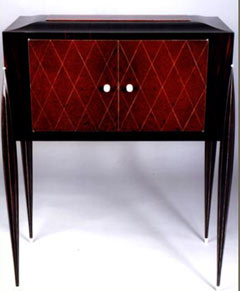
“For years I shunned the title of artist,” Aaron explained, “but I’ve come to the realization that it is not money I am after, but rather that I enjoy the creative process. If I wanted to make a lot of money I would have gone into business with my father and uncle, who are commercial real estate brokers.” Instead, he is busy making the sort of pieces that will be cherished for generations.
“Don’t give up,” he advises others on the path. “Do what you love, and keep doing it until you die. And, most important, don’t give in to those who tell you that you can’t or shouldn’t do something.”





